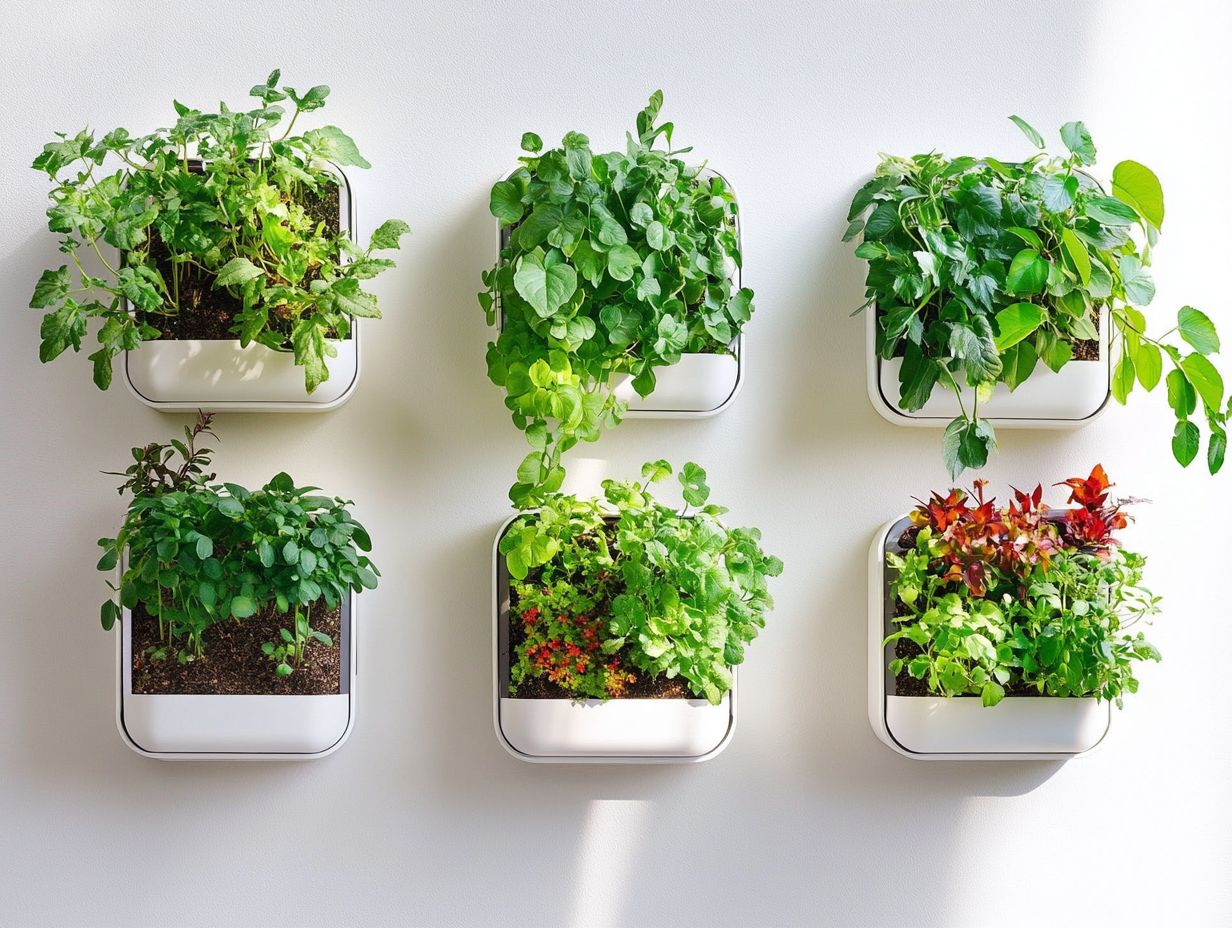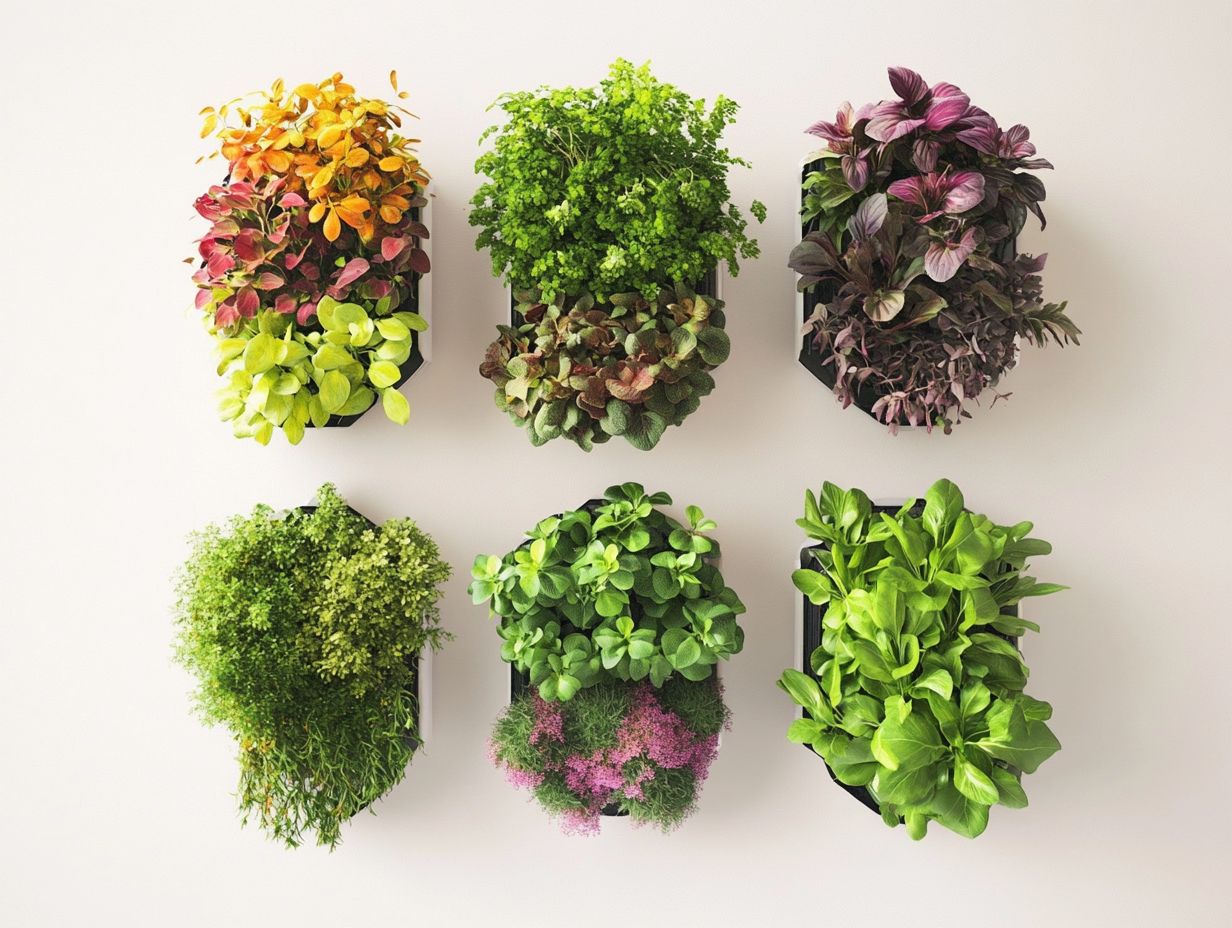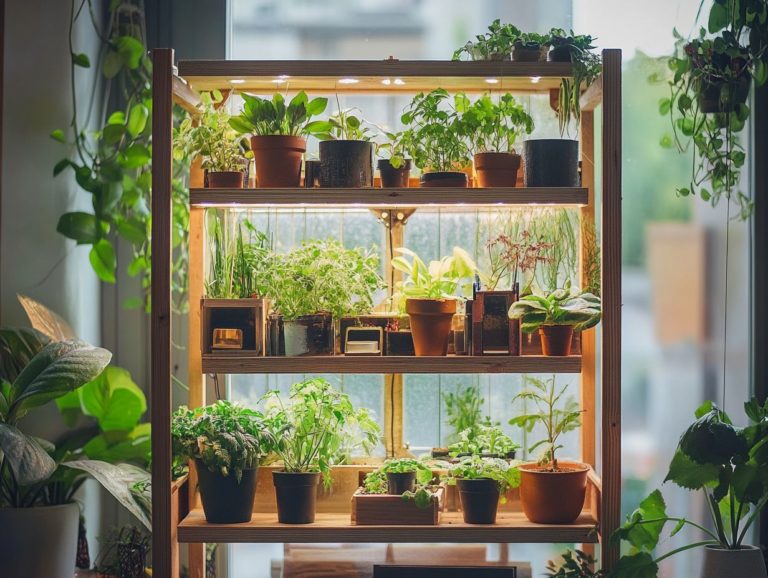5 Unique Hydroponic Garden Designs
Are you prepared to elevate your gardening journey? Hydroponic gardening presents a realm of opportunities, particularly for those navigating limited space or soil constraints.
You ll uncover five distinctive hydroponic garden designs, ranging from vertical towers to floating rafts. Each one can harmonize beautifully with any setting.
You will also explore the many benefits, the mechanics behind these systems, and invaluable tips for constructing your own hydroponic garden. We ll highlight common pitfalls to steer clear of.
Dive into the exciting world of hydroponic gardening and unleash your creativity!
Contents
- Key Takeaways:
- 1. Vertical Garden Tower
- 2. Hanging Garden
- 3. Floating Raft System
- 4. Window Farm
- 5. Wicking Bed System
- What Is Hydroponic Gardening and How Does It Work?
- Frequently Asked Questions
- What are the benefits of using hydroponic garden designs?
- What materials are commonly used in hydroponic garden designs?
- Are there different types of hydroponic garden designs?
- How much maintenance do hydroponic garden designs require?
- Can hydroponic garden designs be used for all types of plants?
- Do hydroponic garden designs require a lot of space?
Key Takeaways:

- Vertical garden towers are a unique way to utilize vertical space and grow a variety of plants in a compact area.
- Hanging gardens are a creative solution for those with limited floor space, allowing plants to be suspended in the air.
- The floating raft system is a low-maintenance hydroponic option that uses a floating platform to support plant growth.
1. Vertical Garden Tower
Vertical garden towers are truly a game-changer for maximizing space in gardening. They enable urban and indoor gardeners like you to cultivate a diverse range of crops, from fragrant herbs to juicy tomatoes and even vibrant edible flowers.
These vertical setups create an ideal environment for your plants, utilizing minimal ground space. This method is perfect for those snug living areas. By adopting hydroponic methods, you can manage nutrient solutions with precision, ensuring your plants receive everything they need for robust, healthy growth.
These towers enhance air circulation and even help reduce pesky intruders like squash bugs that often torment traditional gardens.
With carefully tailored environments, your plants will thrive, frequently producing higher yields thanks to optimized light exposure and moisture levels. This ultimately means you can enjoy fresh, homegrown produce no matter the season.
2. Hanging Garden
Hanging gardens present an exquisite opportunity for outdoor gardening, allowing you to cultivate herbs and edible flowers in vertical spaces. This approach creates stunning displays while making optimal use of limited areas in community gardens.
These vertical landscapes infuse urban settings with charm while promoting sustainability by transforming underutilized spaces into thriving gardens. Consider growing herbs like basil, mint, and oregano; they not only delight the palate but also flourish in containers that gracefully dangle from walls or ceilings.
Adding varieties of edible flowers, such as nasturtiums and violets, introduces vibrant colors and flavors to your meals, making them all the more enticing.
To maintain the health of your hanging garden, it’s crucial to invest time in regular watering and ensuring the right light conditions. Engaging in periodic pruning is also important. Keep a vigilant eye for pesky intruders like aphids and employ organic treatments to protect your plants, enhancing their lively display.
3. Floating Raft System
The floating raft system is an exceptional hydroponic technique that allows you to grow plants directly in nutrient-rich water. This method is highly efficient for crop production while optimizing your water usage.
This innovative approach features a buoyant platform, often crafted from Styrofoam, where you place your seedlings, allowing them to float atop a nutrient solution.
This setup provides essential minerals and vitamins directly to your crops, such as watermelon and tomatoes, promoting rapid growth and robust yields.
Managing the nutrient solution requires you to regularly check its pH and electrical conductivity, ensuring your plants receive the optimal balance they need. Keeping a close eye on plant health is crucial, as it helps you detect any signs of distress or disease early on.
This vigilance aids in preventing common hydroponic gardening pitfalls, like over-fertilization and inadequate light exposure.
Ready to transform your gardening experience? Start your hydroponic journey now!
4. Window Farm

A window farm presents an ingenious opportunity for you to dive into indoor gardening. It enables you to cultivate herbs and vegetables in even the smallest of spaces. By utilizing do-it-yourself methods that grow plants without soil, you can transform any window into a productive growing environment.
As you harness natural sunlight and apply innovative plant-growing techniques, you can create a lush, vibrant ecosystem right in your home. Your setup will typically feature vertical planters, nutrient-enriched water, and efficient irrigation methods. For those with limited space, exploring the top hydroponic systems for small spaces can optimize your setup while maximizing your yield.
You ll find that crops like basil, lettuce, and strawberries thrive in these systems. These are perfect choices whether you re just starting out or are a seasoned gardener. Beyond the personal satisfaction of nurturing your plants, window farming offers the exciting potential for community engagement.
You can collaborate with others on indoor gardening projects, share resources, and promote sustainability through local food production.
5. Wicking Bed System
The wicking bed system is a sustainable farming method that allows you to manage water and nutrients effectively. This ensures your crops develop strong root systems while minimizing water usage. This approach enhances your gardening techniques by mixing compost with your soil.
By embracing this innovative method, you ll boost your plants health dramatically while also reducing your reliance on chemical fertilizers. It makes an eco-friendly choice for any gardener. With a reservoir system and a layer of mulch, your plants will receive consistent moisture while their roots stretch deep and wide, drawing essential nutrients from the soil below.
You ll find that various crops, including vegetables and herbs, thrive in this environment. They benefit from the aerated soil structure that supports robust root development. This system fosters biodiversity, encouraging beneficial microorganisms that contribute to the overall health of your garden ecosystem.
What Is Hydroponic Gardening and How Does It Work?
Hydroponic gardening is a groundbreaking method that allows you to grow plants without soil. It utilizes a nutrient solution to deliver essential minerals directly to the root systems. This approach creates optimized growing conditions and significantly enhances crop production, especially in indoor gardening settings.
Not only does this innovative technique maximize your available space, but it also conserves water and minimizes the risks associated with soil-borne diseases. The principles of hydroponics focus on nourishing plants in a controlled environment. Methods like Nutrient Film Technique (NFT) and Deep Water Culture are highly sought after for their efficiency.
In NFT systems, a thin film of nutrient solution runs over the roots. This ensures they get constant nourishment. Meanwhile, Deep Water Culture allows roots to dangle in oxygen-rich water, promoting rapid growth.
These methods are gaining traction in both urban farming and commercial agriculture, showcasing their versatility and effectiveness across a variety of environments. Discovering DIY hydroponic systems for urban gardening can redefine how you grow your plants and take your gardening skills to a new level!
What Are the Benefits of Hydroponic Gardening?
Hydroponic gardening presents a wealth of benefits that are hard to ignore. You ll enjoy reduced water usage, increased crop production rates, and improved pest control mechanisms, making it a compelling alternative to traditional soil-based gardening.
One of the most impressive advantages of hydroponics is its ability to maximize space efficiency. You can turn small urban spaces into thriving gardens. Unlike conventional gardening, which depends heavily on soil quality and unpredictable weather, hydroponic systems deliver nutrients directly to your plants. For those looking to get started, consider these 7 tips for successful DIY hydroponic gardening. This method results in faster growth cycles and significantly higher yields.
Take leafy greens like lettuce and herbs such as basil, for example. In hydroponic environments, they often thrive, doubling the harvests you might typically achieve through soil cultivation. Hydroponics also uses much less water, as these systems are designed to recycle moisture. This makes it a sustainable solution for food production, particularly in areas grappling with drought or limited arable land. If you’re interested in maximizing space, consider designing a hydroponic garden for small yards.
What Are the Different Types of Hydroponic Systems?

- NFT (Nutrient Film Technique): A method where nutrients flow over plant roots.
- Deep Water Culture: Roots are immersed in a nutrient solution.
- Ebb and Flow: Periodically floods the root zone to provide moisture and aeration.
- Vertical systems: Maximizes space optimization in urban settings.
These systems employ different methods to deliver nutrients and oxygen directly to plant roots, optimizing growth rates and maximizing yields. For example, with NFT, a thin film of nutrient-rich water flows over the roots, making it a perfect choice for leafy greens. On the other hand, Deep Water Culture immerses the roots in a nutrient solution, which is ideal for fast-growing plants like herbs.
Ebb and Flow systems offer versatility, as they periodically flood the root zone, providing a balanced blend of moisture and aeration for diverse crops. If space is at a premium, vertical systems are a game changer for maximizing space optimization. To enhance your setup further, consider these 5 upgrades for your existing hydroponic system. They enable you to grow a stunning variety of plants in urban settings, turning your living space into a thriving garden.
How Can One Build Their Own Hydroponic Garden?
Building your own hydroponic garden is not just a DIY project; it’s an exhilarating adventure to create your personal growing paradise! You’ll want to gather essential components like a suitable grow medium (the material that supports your plants), organic compost, an air stone, and a meticulously prepared nutrient solution to guarantee optimal plant growth.
This exciting gardening method saves space and gives you faster harvests, making it a truly rewarding pursuit for anyone eager to cultivate fresh produce right in the comfort of home. To embark on this journey, collect the necessary materials, such as containers, a reliable water pump, and grow lights that effectively simulate sunlight for indoor setups. For best results, consider following these 7 tips for successful hydroponic gardening.
As you set up your garden, pay careful attention to light placement and maintain consistent water levels—both crucial for supporting plant health. For those just starting out, it’s wise to begin with easy-to-grow herbs like basil and cilantro, or vegetables such as lettuce and spinach, which thrive in hydroponic systems. If you’re interested in expanding your skills, check out these top 10 DIY hydroponic projects for beginners.
Regularly monitoring nutrient levels and pH will not only enhance growth but also ensure a bountiful harvest of homegrown herbs, rewarding your efforts with the fruits of your labor.
Don’t wait start your hydroponic garden today and enjoy fresh produce at your fingertips!
What Are the Common Mistakes to Avoid in Hydroponic Gardening?
Many new hydroponic gardeners often stumble upon common missteps that can seriously hinder plant growth, such as mismanaging nutrient solutions and pest control. Additionally, failing to provide adequate light and neglecting common gardening problems can also be detrimental.
These oversights can lead to stunted growth, illnesses, or even plant death, making your gardening journey feel overwhelming. For instance, it s easy to underestimate the importance of maintaining the right pH level and electrical conductivity (EC) which measures the nutrient levels of your nutrient solution, both of which are crucial for optimal nutrient absorption. Inadequate lighting can leave your plants weak and leggy as they stretch toward any glimmer of light, while pests can multiply unchecked without regular monitoring.
To navigate these challenges effectively, you should consider:
- Investing in pH and EC meters.
- Ensuring your growing area is well-lit.
- Regularly inspecting your plants for any signs of infestation.
By proactively addressing these issues, you can cultivate a thriving hydroponic garden that truly flourishes.
How Can Hydroponic Gardening Be Used in Small Spaces?
Hydroponic gardening serves as the perfect solution for small spaces. It enables you, the urban dweller, to embrace vertical farming techniques, which involve stacking plants vertically to save space, and hydroponic systems that help you grow more plants in even the most confined areas, like balconies or kitchens.
By incorporating designs such as tiered shelves or wall-mounted systems, you can transform your limited space into a vibrant green oasis. Container gardens, utilizing various-sized pots and containers, further support your endeavor to grow flavorful herbs and vibrant vegetables. For beginners interested in maximizing their gardening potential, exploring the top hydroponic growing systems can help you cultivate everything from fragrant basil and cilantro to sweet cherry tomatoes or even giant pumpkins.
Opting for fast-growing crops, such as tomatoes or herbs, that flourish in hydroponic setups not only enhances your space aesthetically but also delivers a gratifying sense of achievement. You can harvest your bounty in weeks rather than months. Hydroponics isn’t just practical; it’s a rewarding way to elevate your culinary experiences while maximizing your available space. Consider exploring 5 unique hydroponic systems to try this year for even more gardening options.
Frequently Asked Questions

What are the benefits of using hydroponic garden designs?
Hydroponic garden designs offer a space-saving alternative to traditional gardens and allow for year-round growing of tea, herbs, and various crops. They also use less water and can produce higher yields than traditional soil gardens, supporting sustainable farming practices.
What materials are commonly used in hydroponic garden designs?
Some common materials used in hydroponic garden designs include PVC pipes, buckets, plastic bottles, and grow trays. Some hydroponic systems need pumps, timers, air stones, and grow lights.
Are there different types of hydroponic garden designs?
Yes, there are various types of hydroponic garden designs, such as deep water culture, ebb and flow, and drip systems. Each type has its own unique set-up and method of delivering nutrients to the plants.
How much maintenance do hydroponic garden designs require?
Hydroponic garden designs require less maintenance compared to traditional gardens, as there is no soil to weed or water. However, regular checks on pH and nutrient levels are necessary, and occasional cleaning of the system may be required.
Can hydroponic garden designs be used for all types of plants?
Yes, hydroponic garden designs can be used for a wide variety of plants, including edible flowers, herbs, vegetables, and even pumpkins. However, certain plants may require specific nutrient solutions and lighting to thrive in a hydroponic system.
Do hydroponic garden designs require a lot of space?
You don’t need a lot of space for hydroponic gardens! They fit perfectly in apartments, balconies, and indoor areas.
Plus, you can build them vertically to make the most out of your space!






